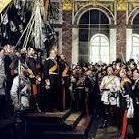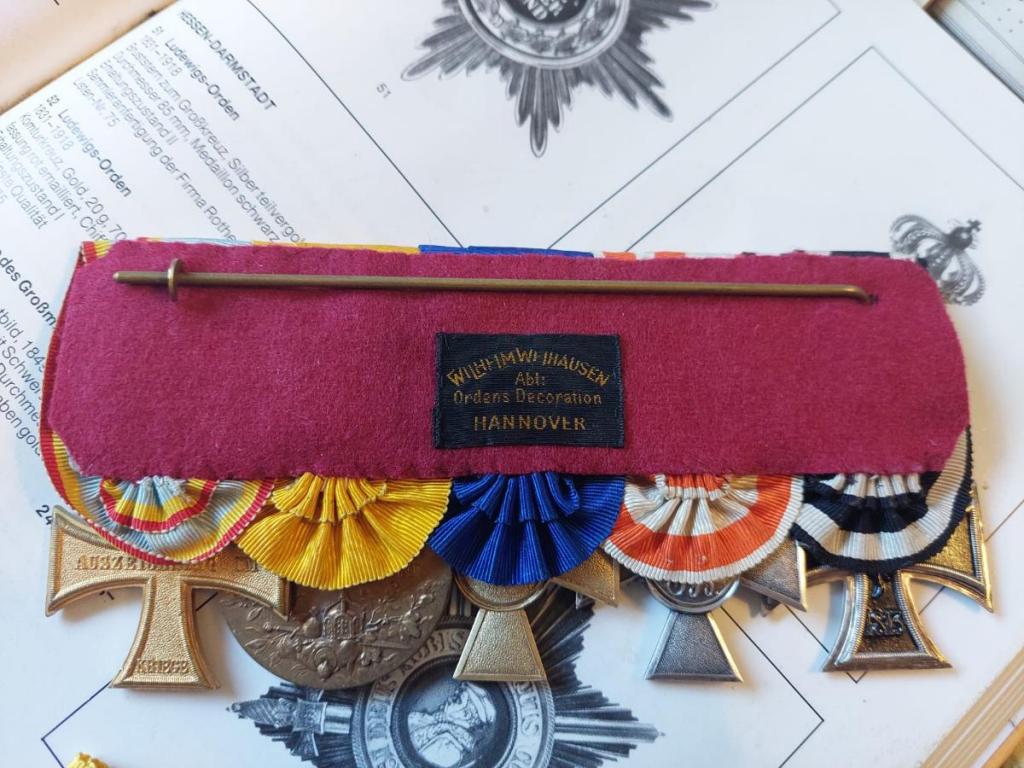-
Posts
674 -
Joined
-
Last visited
-
Days Won
6
Content Type
Profiles
Forums
Blogs
Gallery
Events
Store
Everything posted by laurentius
-
As often with certain members of the Wilhelmine era this will be a long, but do-able list. Starting at the neck with: - Grandcross of the Iron Cross - Pour le Merité with oakleaves - Holy Order of the Annunciation (an Italian Roman-Catholic decoration, although sometimes bestowed on non-catholics like Moltke) - Russian Order of St. George This is followed by the sash of the Order of the Black Eagle, below this sash is a cross of the Rechtsritter of the Johanniter-Orden. His medalbar, as often with high-ranking members of the Belle Epoque-era the medalbar is sadly worn below the sash which hinders us from identification. Given his rank there is most likely a correct identification of awards somewhere on the forum. His breast is filed with several high German Orders, being: - Grandcross of the Order of the Black Eagle with diamonds - Baden House Order of Loyalty (Hausorden der Treue) - Saxon Order of the Rue Crown (Orden der Rautenkrone) - Grandcross of the Holy Order of the Annunciation (goes with the necklace) - Saxe-Weimar-Eisenach Order of the White Falcon (Weißen Falken-Orden or Hausorden der Wachsamkeit) - Mecklenburgian Order of the Wendish Crown ( Orden der Wendische Krone) - Last but not least, the EK1 from 1870 A nice picture with Moltke and his more modest attire of orders and decorations. I hope you find this list helpful. Kind regards, Laurentius
-
So, to summarize, the regents did not hand out any non-Brunswick decorations. Were there officials who did receive a Prussian or Mecklenburgian decoration from the Prussian king or the Mecklenburgian Grandduke for their role during the regency? Members of Brunswick society would receive some decorations just like their German and non-German counterparts but are there known decorations for helping under the regency or for helping Ernst August get started in 1913? Kind regards and thanks in advance, Laurentius
-
I don't think Scharffenberg made this piece, although it does share some characteristics. Given Scharffenberg's location (Dresden, capital of the Kingdom of Saxony) and the decorations of this medalbar I think it might have been a home job. Perhaps as @Simius Rex mentioned done by the half-blind grandmother of a soldier who got the hardware for the medalbar from the same place as Scharffenberg. Made Scharffenberg even sold hardware to make your own medalbars. It is sometimes hard to imagine when wandering this great forum, but most bars were made in an okay-quality by housewifes, mothers or sowing-savvy soldiers who did it themselves. Having your medals mounted would usually start at prices of half a mark, going up per decoration (logical, since the base plate needs to be larger and more ribbon is used). This is the type of spare cash most veterans did not have after the war, which is why most medalbars are in a less-than-fortune state or why some medals were never mounted at all. The more you spend on your medalbar, the better it is preserved. It is no wonder most minty medalbars have a tag from one the top jewellers, these ones were made to last. A good investment which sadly most couldn't afford. Kind regards, Laurentius
-
No need to apologize. I was thinking more along the lines of decorations to officers and civil servants which you already answered. The regents continued to issue the Brunswick orders and decorations. Did these regents also have the right to issue Mecklenburgian or Prussian decorations? Kind regards and thanks in advance, Laurentius
-
Dear fellow collectors, When Wilhelm Herzog von Braunschweig died in 1886 the duchy of Brunswick was put under a Prussian regency to prevent the House of Hannover from ruling the duchy and possibly try to regain their former kingdom to the north. This regency lasted from 1886 untill 1913 when Ernst August, the son-in-law of Emporer Wilhelm II was made duke. His father Ernst August had been the original heir in 1886. The regency can be divided into two periods: the Prussian period under Albrecht prince of Prussia and a Mecklenburgian period under Johann Albrecht duke of Mecklenburg. I was wondering how decorations were bestowed during this period. Did the regents continue to award the Brunswickian orders or did they receive Prussian/Mecklenburgian decorations? Kind regards and thanks in advance, Laurentius
-
Here you go. The medalbar was made by Wilhelm Welhausen from Hannover, a wellknown maker of high-quality bars. This can be seen from the double ribbon used on the back and the thread which secures the medals around the ring. The RAO4 is made by J.H. Werner, just like my other RAO. The maker, together with the Mecklenburg connection is the reason I bought it. Given the Centenary medal, the DA and the RAO @Nicolas7507 and I came to the conclusion that he was most likely a major in a staff position, although you can never know for certain. This is the reason I asked what the job of staff officer would precisely entail, I find it rather intriguing. Kind regards, Laurentius
-
Dear fellow collectors, I recently acquired a medalbar I think would have belonged to a staff officer in the rank of major. I was wondering what kind of duties someone working in the staff would have? Would this be planning, keeping contact with the troops, administering supplies? Certainly where he did this would be important too, a staff officer on the western front would have wholely different circumstances to work under than say an officer on the Italian or the Romanian front. Do you guys have any thoughts or ideas? Kind regards, Laurentius
-
I wholeheartedly agree. Although the bar is in good condition you can see the wear and tear that slowly occurs both from wearing and from not wearing (where a bar is stored is just as important as the way it is mounted and the way it is being worn). The ribbon is a little faded, some little natural staining (unlike the tea-stains fakers tend to use) and the fraying of the white ribbon tying down the crosses show us the more than century old materials that together constitute this bar. It's probably not the first bar a starting collector will buy but the techniques used to identify genuine and fake pieces can be used on all bars.
-
Thank you Andreas, a fine biography, sadly it doesn't specify whether he produced for Austria too (if my German translation is correct he made civil and military orders for Bulgaria). Kind regards, Laurentius
-
Dear fellow collectors, I had a question regarding Juweler Joh. Schwerdtner from the Mariahilferstraße in Vienna. I was unsure where to ask this question since this viennesse juweler primarily produced for the Bulgarian Tsardom. I was wondering how long the company existed (it stopped producing somewhere in the 1920's) and whether they also produced for the Austro-Hungarian empire and other countries? Kind regards and thanks in advance, Laurentius
-
A peculiar bird, there are many things I find questionable on this RAO, especially the design of the eagle. My cross 4th class has a better one than this 2nd class piece. I'm not the most knowledgeable on these so I'll wait for the more experienced collectors to give their opinion. Kind regards, Laurentius
-
Perfectly possible. Many NCO's got promoted to junior officers due to the sheer lack of young men who reached the standard of the officers corps. Combinations with NCO/junior officer level awards can be found quite frequently on the market. This is especially demonstrated with Bavarian bars containing both MVK's and MVO's. Given the fact he wears the MMC before the EK (a weird combo often observed at the beginning of the 1920's, same goes for HoHx-EK combinations) I would suggest that this man is a Prussian rather than a Saxon Kind regards, Laurentius
-
Dear Iew, The painting of Alfred Gölitz does show a greenish ribbon next to the EK-ribbon which could be the Albrechtsorden. Given his rank and the fact he wears a three-piece ribbonbar in the 1939 photo makes me reluctant to believe the medalbar is his. Maybe he had an older brother, a father or a nephew? Families usually don't keep very good track of things like this, which results in these kind of problems. All identification problems apart, a lovely bar and a lovely photo, I am jealous. Kind regards, Laurentius



.thumb.jpeg.518e293c950954df6fcb8aba70ef9abb.jpeg)
